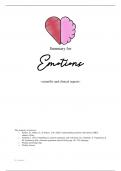Summary
Summary Emotions: Scientific & Clinical Aspects (500192-B-6)
- Course
- Institution
- Book
This summary is a detailed, easy-to-read and well-organised summary of the mandatory read, knowledge clips and course notes. For a better understanding, the summary also contains pictures and tables.
[Show more]



